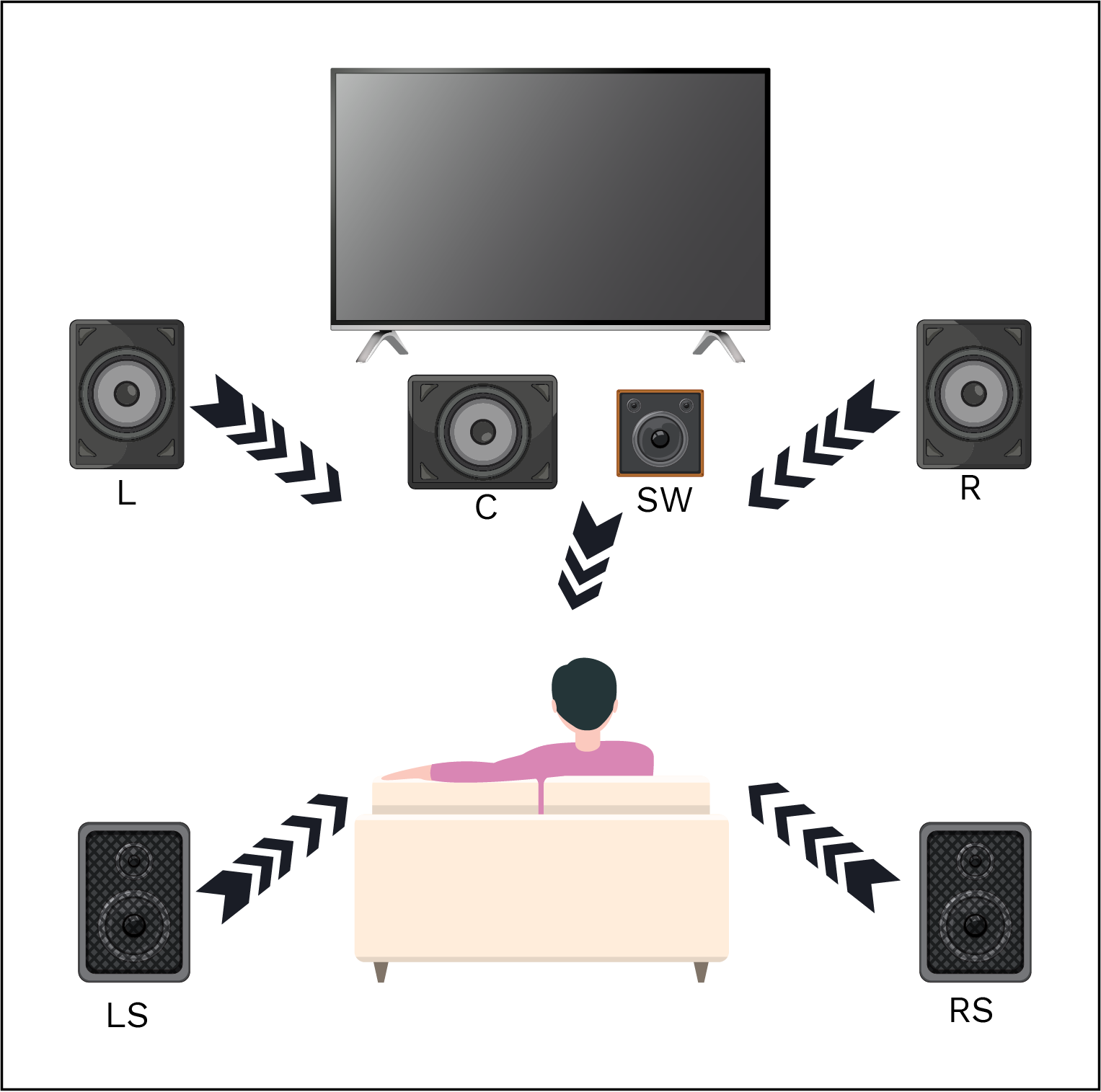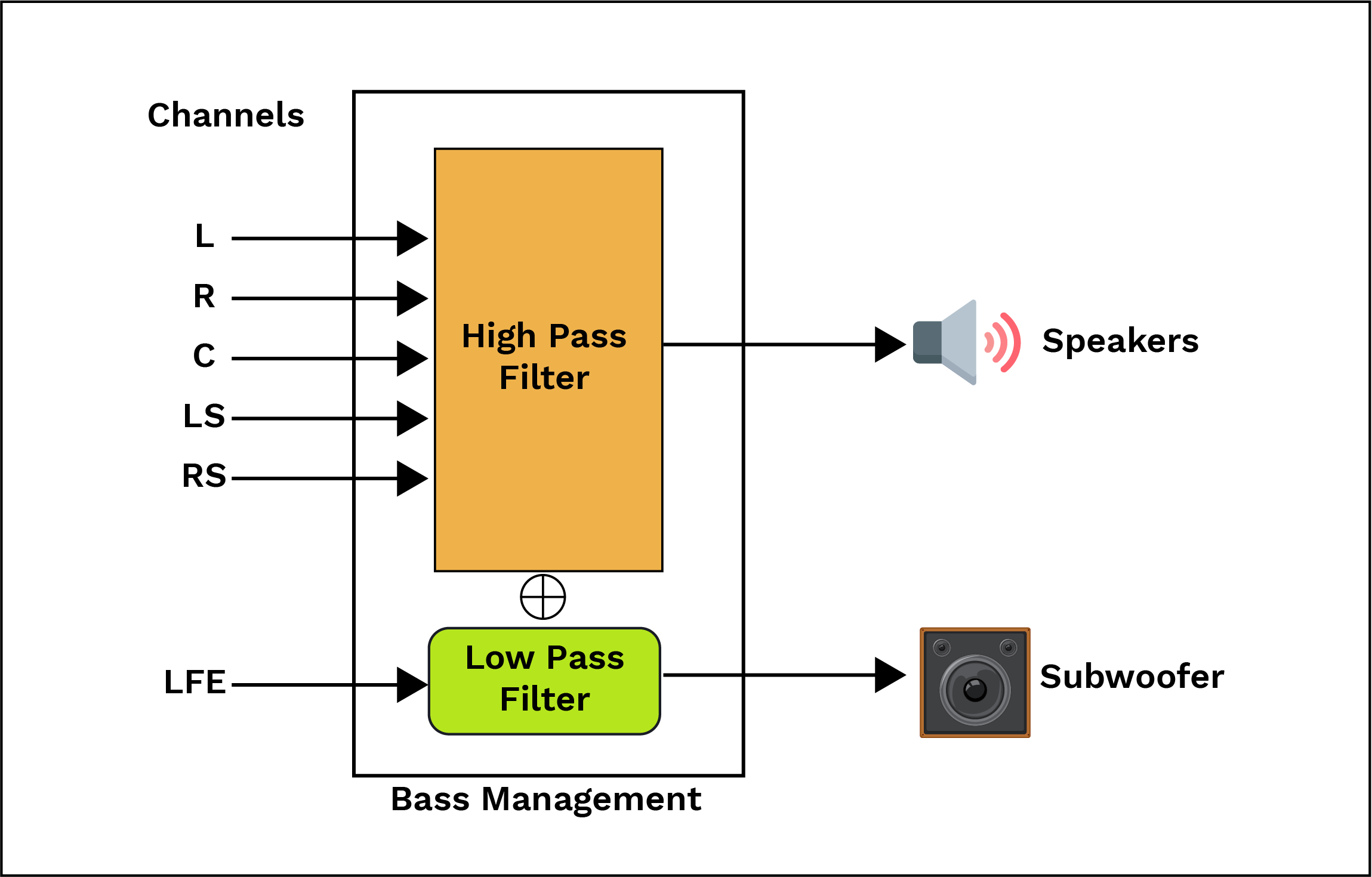To enhance the audio experience, superior audio quality is essential, with surround sound support being a bonus. This article focuses on the home user, where audio listening is most prevalent.
Bass management’s main purpose in home theater or multichannel audio system is to improve the sound quality and intensity. To do this, we’ll need appropriate loudspeakers that accent one another better. The majority of the speakers in an ordinary home theater are incapable of reproducing frequencies at levels required for a home theater. In such cases, bass management is used for audio processing to filter out low frequencies from the speaker channel and deliver them to the sub-woofer.
Let’s understand the bass management configuration on the technical side: Stereo sound playback includes Left and Right channel audio processing and multichannel (i.e., 5.1 channel) consists Left (L), Center (C), Right (R), Left Surround (LS), Right Surround (RS) and Low Frequency Effect (LFE) channel configuration. Bass management is built with the L, C, R, LS, and RS channels, and an additional LFE channel (also known as sub-woofer).
Windows audio driver enhances the quality of audio sound associated with home theater stereo surround sound system. The recently introduced custom APO’s LFE channel is used by the Windows Audio Processing Object (APO) to add bass management capability, improving the Windows audio experience. Technically, all the sound frequencies from the five full range channels (L, C, R, LS, and RS) are sent into a single mono subwoofer via the bass management system, together with the LFE. There are primarily two audio systems or configurations used: 5.1 channel and 7.1 channel (i.e. L, C, R, LS, RS, with an extra two rear surround channels labeled LRS and RRS).
Using a bass management or surround sound system, users can assign output sound to specific channels. For example, when playing movie content that includes both dialogue and music, these elements can be distributed across supported channels such as front, center, rear, or sub-woofer. Technically, the sound system separates the sound frequencies and directs them to the appropriate channels.

LFE in Bass Management
The Low-Frequency Effects (LFE) channel is an electrical signal output to the sub-woofer transducer that is used for low frequency sounds. The LFE channel is intended to be played by sub-woofers capable of handling very low frequency sound in the 60Hz ~ 160Hz frequency range. It is a low frequency channel with extra headroom (+10 db) used to create extra bass in the surround sound system. In the bass management system (e.g. 5.1 or 7.1), .1 refers to the LFE speaker channel and low frequency branch to sub-woofer. If you’re not using a sub-woofer, ensuring proper bass management directs LFE information to your other speakers.
Bass Management’s Crossover Frequency
Crossover frequency in bass management is the low-pass signal routed to the bass enhancement path, and the high-pass signal routed to the spatial widening path. It means the frequency is divided between surround speakers and the sub-woofer. Let’s look at a 5.1 surround sound system, where sound signals from five speakers are routed through a high-pass filter that filters out frequencies beyond the defined cutoff frequency to their respective speakers. Additionally, a low-pass filter sifts out low frequencies below the cutoff frequency from each channel to the sub-woofer. All other channels’ low frequencies merge with the LFE channel and are redirected to the sub-woofer.
Bass Management’s Speaker Size
This is based on the low frequency limitations of the audio driver. The low-pass filter cutoff frequency and the band-pass filter center frequencies are adjusted to match the frequency responses of the speakers being used. The size of the speaker is used to inform the system based on a cutoff frequency how much bass the speaker can produce. Signals that fall below this frequency are rerouted to a different speaker or sub-woofer in the system.

Effects of Bass Management Enablement
- Bass management enables quality music or audio listening experience to the end users.
- Included sub-woofer enables the system’s frequency response to the lowest audible limit.
- Bass management permits feeding of all channels’ bass to a single sub-woofer to reproduce high quality sound.
- It facilitates producing the greatest audio possible with authentic, real-life sound.
Bass Management Downside
- While it does improve sound quality with less expensive speakers, it diverts attention from speaker functioning when used with higher-end speakers.
- Only when it is configured precisely—which requires precise understanding of bass management—can it produce high-quality sound.
Conclusion
The overall surround sound experience relies heavily on the bass management system. To achieve a good surround sound experience, it is essential to have both high-quality and low-level surround speakers. When configuring the LFE sub-woofer, it’s possible to choose the speaker size to incorporate a low-pass filter into the LFE channel. To put it succinctly, bass management goes beyond simply sending all the bass to a single sub-woofer.
Know More- Multimedia And Digital Solution
Glossary
| Term | Definition |
| Low-frequency effects (LFE) | Electrical signal output to subwoofer transducer |
| Audio processing object (APO) | COM host object provide software based digital signal processing |
| Left (L) | Left Audio Channel |
| Center (C) | Center Audio Channel |
| Right (R) | Right Audio Channel |
| Left Surround (LS) | Left Surround Audio Channel |
| Right Surround (RS) | Right Surround Audio Channel |
| Subwoofer (SW) | Speaker produces low frequencies |













